engine coolant Alfa Romeo GT 2005 Owner handbook (in English)
[x] Cancel search | Manufacturer: ALFA ROMEO, Model Year: 2005, Model line: GT, Model: Alfa Romeo GT 2005Pages: 307, PDF Size: 6.05 MB
Page 54 of 307
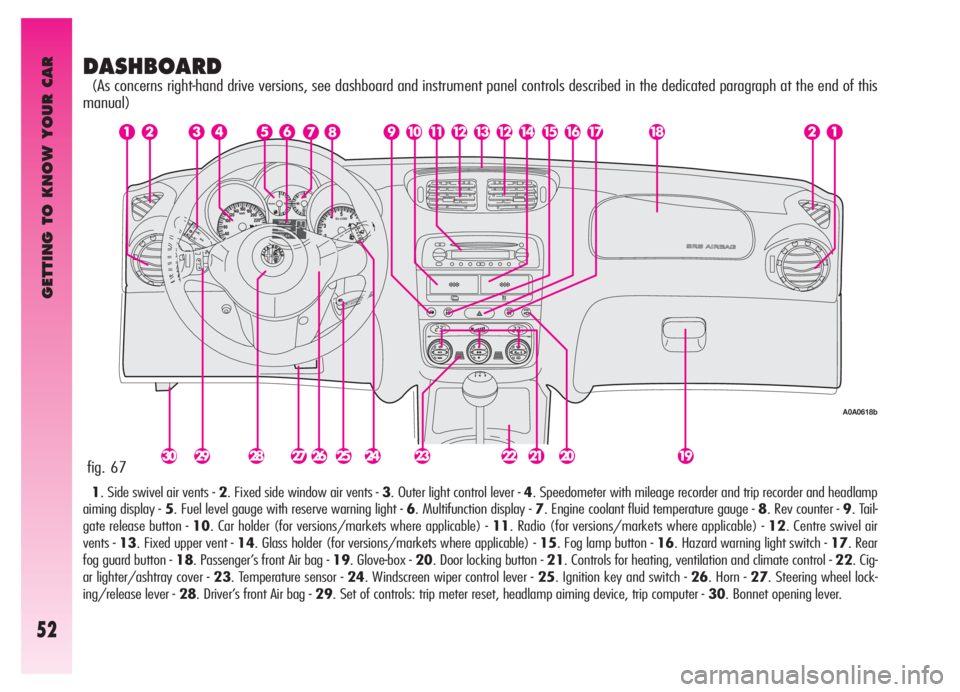
GETTING TO KNOW YOUR CAR
52
DASHBOARD
(As concerns right-hand drive versions, see dashboard and instrument panel controls described in the dedicated paragraph at the end of this
manual)
1. Side swivel air vents - 2. Fixed side window air vents - 3. Outer light control lever - 4. Speedometer with mileage recorder and trip recorder and headlamp
aiming display - 5. Fuel level gauge with reserve warning light - 6. Multifunction display - 7. Engine coolant fluid temperature gauge - 8. Rev counter - 9. Tail-
gate release button - 10. Car holder (for versions/markets where applicable) - 11. Radio (for versions/markets where applicable) - 12. Centre swivel air
vents - 13. Fixed upper vent - 14. Glass holder (for versions/markets where applicable) - 15. Fog lamp button - 16. Hazard warning light switch - 17. Rear
fog guard button - 18. Passenger’s front Air bag - 19. Glove-box - 20. Door locking button - 21. Controls for heating, ventilation and climate control - 22. Cig-
ar lighter/ashtray cover - 23. Temperature sensor - 24. Windscreen wiper control lever - 25. Ignition key and switch - 26. Horn - 27. Steering wheel lock-
ing/release lever - 28. Driver’s front Air bag - 29. Set of controls: trip meter reset, headlamp aiming device, trip computer - 30. Bonnet opening lever.
fig. 67
A0A0618b
Page 55 of 307
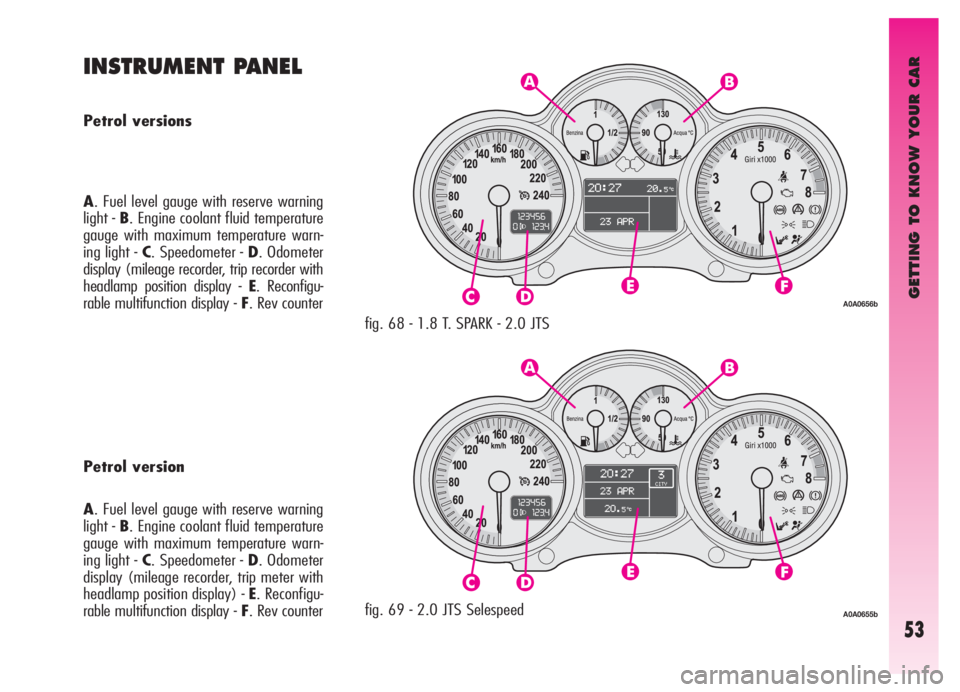
GETTING TO KNOW YOUR CAR
53
A. Fuel level gauge with reserve warning
light - B. Engine coolant fluid temperature
gauge with maximum temperature warn-
ing light - C. Speedometer - D. Odometer
display (mileage recorder, trip recorder with
headlamp position display - E. Reconfigu-
rable multifunction display - F. Rev counter
Petrol version
A. Fuel level gauge with reserve warning
light - B. Engine coolant fluid temperature
gauge with maximum temperature warn-
ing light - C. Speedometer - D. Odometer
display (mileage recorder, trip meter with
headlamp position display) - E. Reconfigu-
rable multifunction display - F. Rev counter
INSTRUMENT PANEL
Petrol versions
fig. 68 - 1.8 T. SPARK - 2.0 JTS
fig. 69 - 2.0 JTS Selespeed
A0A0656b
A0A0655b
Page 56 of 307
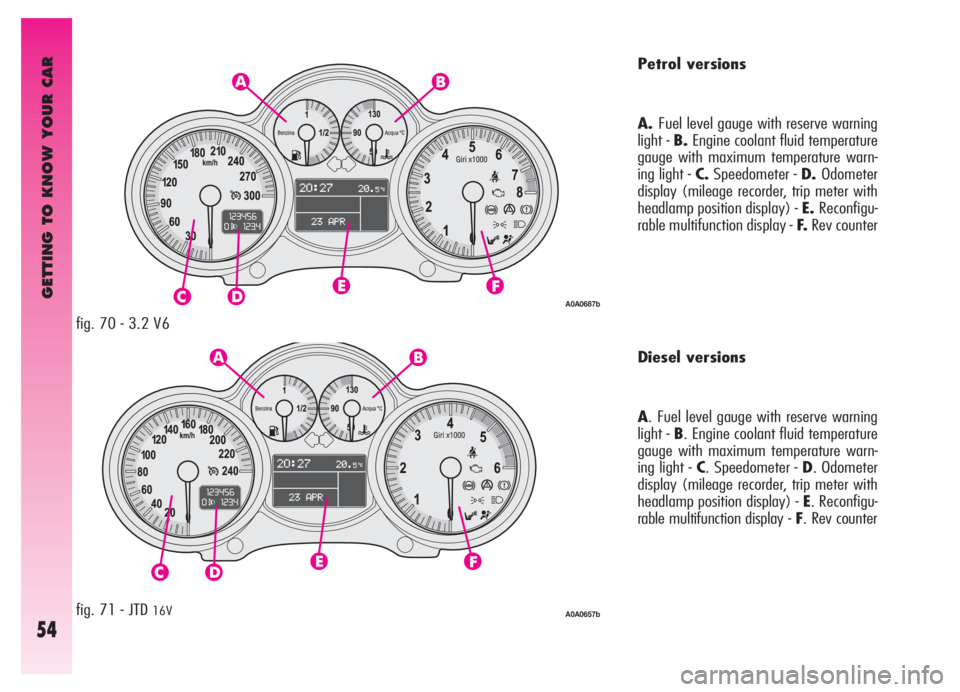
GETTING TO KNOW YOUR CAR
54
fig. 70 - 3.2 V6
fig. 71 - JTD 16V
Petrol versions
A.Fuel level gauge with reserve warning
light - B.Engine coolant fluid temperature
gauge with maximum temperature warn-
ing light - C.Speedometer - D.Odometer
display (mileage recorder, trip meter with
headlamp position display) - E.Reconfigu-
rable multifunction display - F.Rev counter
Diesel versions
A. Fuel level gauge with reserve warning
light - B. Engine coolant fluid temperature
gauge with maximum temperature warn-
ing light - C. Speedometer - D. Odometer
display (mileage recorder, trip meter with
headlamp position display) - E. Reconfigu-
rable multifunction display - F. Rev counter
A0A0687b
A0A0657b
Page 58 of 307
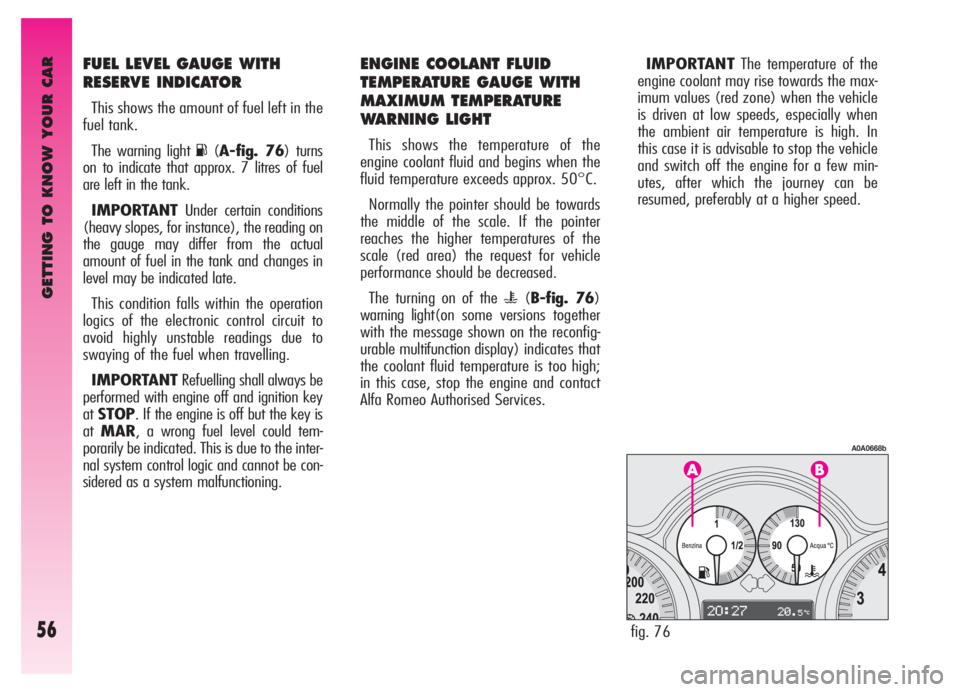
GETTING TO KNOW YOUR CAR
56
FUEL LEVEL GAUGE WITH
RESERVE INDICATOR
This shows the amount of fuel left in the
fuel tank.
The warning light
K(A-fig. 76) turns
on to indicate that approx. 7 litres of fuel
are left in the tank.
IMPORTANTUnder certain conditions
(heavy slopes, for instance), the reading on
the gauge may differ from the actual
amount of fuel in the tank and changes in
level may be indicated late.
This condition falls within the operation
logics of the electronic control circuit to
avoid highly unstable readings due to
swaying of the fuel when travelling.
IMPORTANTRefuelling shall always be
performed with engine off and ignition key
atSTOP. If the engine is off but the key is
atMAR, a wrong fuel level could tem-
porarily be indicated. This is due to the inter-
nal system control logic and cannot be con-
sidered as a system malfunctioning.
ENGINE COOLANT FLUID
TEMPERATURE GAUGE WITH
MAXIMUM TEMPERATURE
WARNING LIGHT
This shows the temperature of the
engine coolant fluid and begins when the
fluid temperature exceeds approx. 50°C.
Normally the pointer should be towards
the middle of the scale. If the pointer
reaches the higher temperatures of the
scale (red area) the request for vehicle
performance should be decreased.
The turning on of the
u(B-fig. 76)
warning light(on some versions together
with the message shown on the reconfig-
urablemultifunction display) indicates that
the coolant fluid temperature is too high;
in this case, stop the engine and contact
Alfa Romeo Authorised Services.IMPORTANTThe temperature of the
engine coolant may rise towards the max-
imum values (red zone) when the vehicle
is driven at low speeds, especially when
the ambient air temperature is high. In
this case it is advisable to stop the vehicle
and switch off the engine for a few min-
utes, after which the journey can be
resumed, preferably at a higher speed.
fig. 76
A0A0668b
Page 87 of 307
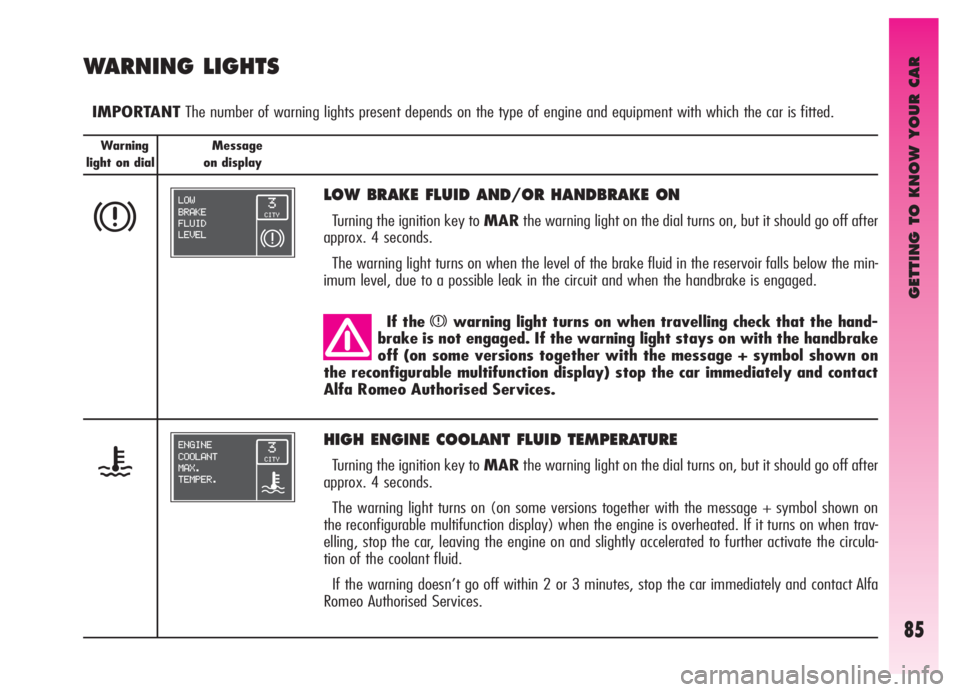
GETTING TO KNOW YOUR CAR
85
Warning
light on dialMessage
on display
WARNING LIGHTS
IMPORTANTThe number of warning lights present depends on the type of engine and equipment with which the car is fitted.
x
LOW BRAKE FLUID AND/OR HANDBRAKE ON
Turning the ignition key to MARthe warning light on the dial turns on, but it should go off after
approx. 4 seconds.
The warning light turns on when the level of the brake fluid in the reservoir falls below the min-
imum level, due to a possible leak in the circuit and when the handbrake is engaged.
If the
xwarning light turns on when travelling check that the hand-
brake is not engaged. If the warning light stays on with the handbrake
off (on some versions together with the message + symbol shown on
the reconfigurable multifunction display) stop the car immediately and contact
Alfa Romeo Authorised Services.
u
HIGH ENGINE COOLANT FLUID TEMPERATURE
Turning the ignition key to MARthe warning light on the dial turns on, but it should go off after
approx. 4 seconds.
The warning light turns on (on some versions together with the message + symbol shown on
the reconfigurable multifunction display) when the engine is overheated. If it turns on when trav-
elling, stop the car, leaving the engine on and slightly accelerated to further activate the circula-
tion of the coolant fluid.
If the warning doesn’t go off within 2 or 3 minutes, stop the car immediately and contact Alfa
Romeo Authorised Services.
Page 110 of 307
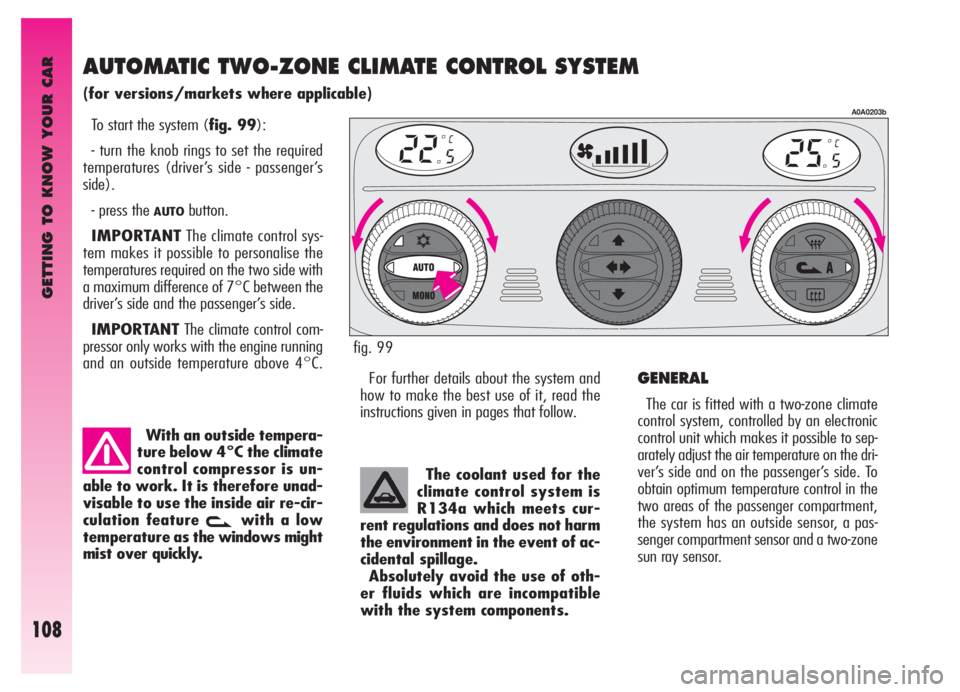
GETTING TO KNOW YOUR CAR
108
AUTOMATIC TWO-ZONE CLIMATE CONTROL SYSTEM
(for versions/markets where applicable)
To start the system (fig. 99):
- turn the knob rings to set the required
temperatures (driver’s side - passenger’s
side).
- press the
AUTObutton.
IMPORTANTThe climate control sys-
tem makes it possible to personalise the
temperatures required on the two side with
a maximum difference of 7°C between the
driver’s side and the passenger’s side.
IMPORTANTThe climate control com-
pressor only works with the engine running
and an outside temperature above 4°C.
With an outside tempera-
ture below 4°C the climate
control compressor is un-
able to work. It is therefore unad-
visable to use the inside air re-cir-
culation feature
vwith a low
temperature as the windows might
mist over quickly.
For further details about the system and
how to make the best use of it, read the
instructions given in pages that follow.
A0A0203b
fig. 99
The coolant used for the
climate control system is
R134a which meets cur-
rent regulations and does not harm
the environment in the event of ac-
cidental spillage.
Absolutely avoid the use of oth-
er fluids which are incompatible
with the system components.
GENERAL
The car is fitted with a two-zone climate
control system, controlled by an electronic
control unit which makes it possible to sep-
arately adjust the air temperature on the dri-
ver’s side and on the passenger’s side. To
obtain optimum temperature control in the
two areas of the passenger compartment,
the system has an outside sensor, a pas-
senger compartment sensor and a two-zone
sun ray sensor.
Page 115 of 307
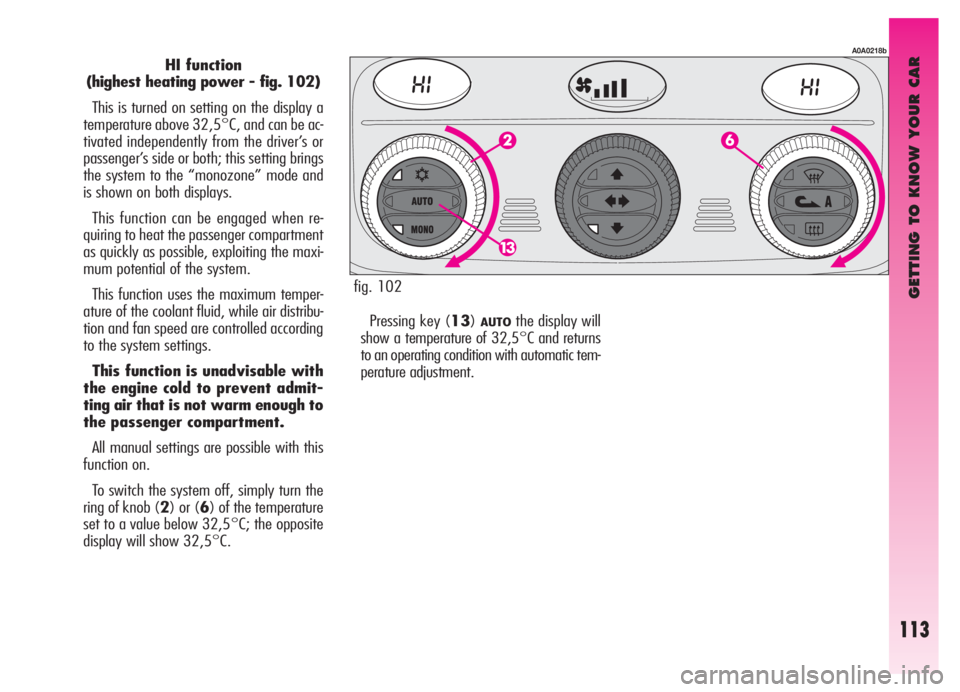
GETTING TO KNOW YOUR CAR
113
HI function
(highest heating power - fig. 102)
This is turned on setting on the display a
temperature above 32,5°C, and can be ac-
tivated independently from the driver’s or
passenger’s side or both; this setting brings
the system to the “monozone” mode and
is shown on both displays.
This function can be engaged when re-
quiring to heat the passenger compartment
as quickly as possible, exploiting the maxi-
mum potential of the system.
This function uses the maximum temper-
ature of the coolant fluid, while air distribu-
tion and fan speed are controlled according
to the system settings.
This function is unadvisable with
the engine cold to prevent admit-
ting air that is not warm enough to
the passenger compartment.
All manual settings are possible with this
function on.
To switch the system off, simply turn the
ring of knob (2) or (6) of the temperature
set to a value below 32,5°C; the opposite
display will show 32,5°C.
A0A0218b
fig. 102
Pressing key (13)
AUTOthe display will
show a temperature of 32,5°C and returns
to an operating condition with automatic tem-
perature adjustment.
Page 203 of 307
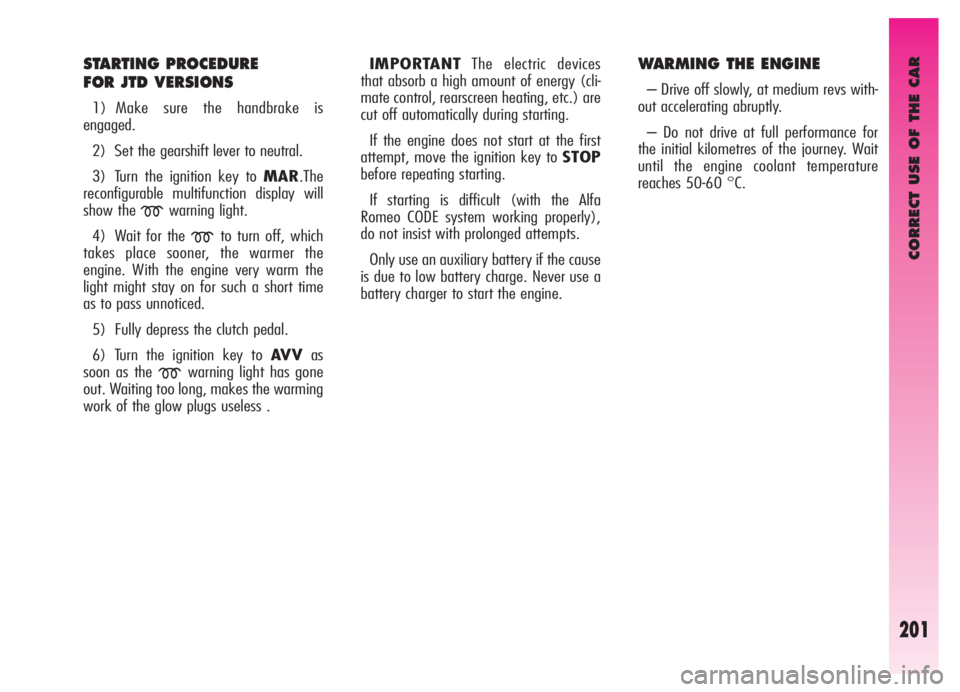
CORRECT USE OF THE CAR
201
STARTING PROCEDURE
FOR JTD VERSIONS
1) Make sure the handbrake is
engaged.
2) Set the gearshift lever to neutral.
3) Turn the ignition key to MAR.The
reconfigurable multifunction display will
show the
mwarning light.
4) Wait for the
mto turn off, which
takes place sooner, the warmer the
engine. With the engine very warm the
light might stay on for such a short time
as to pass unnoticed.
5) Fully depress the clutch pedal.
6) Turn the ignition key to AV Vas
soon as the
mwarning light has gone
out. Waiting too long, makes the warming
work of the glow plugs useless .IMPORTANTThe electric devices
that absorb a high amount of energy (cli-
mate control, rearscreen heating, etc.) are
cut off automatically during starting.
If the engine does not start at the first
attempt, move the ignition key to STOP
before repeating starting.
If starting is difficult (with the Alfa
Romeo CODE system working properly),
do not insist with prolonged attempts.
Only use an auxiliary battery if the cause
is due to low battery charge. Never use a
battery charger to start the engine.
WARMING THE ENGINE
– Drive off slowly, at medium revs with-
out accelerating abruptly.
– Do not drive at full performance for
the initial kilometres of the journey. Wait
until the engine coolant temperature
reaches 50-60 °C.
Page 250 of 307
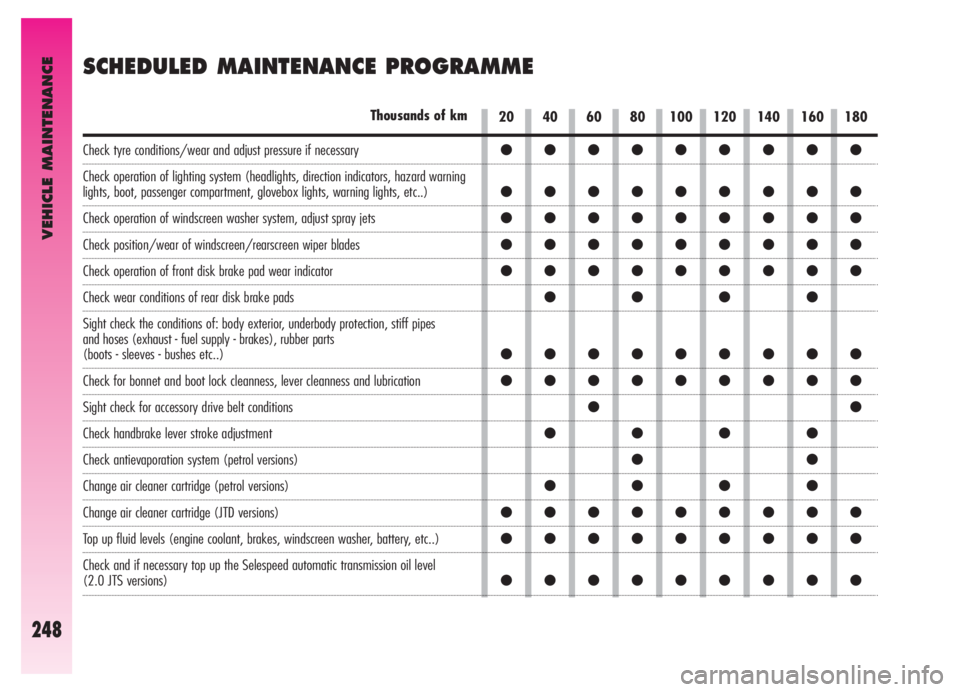
VEHICLE MAINTENANCE
248
SCHEDULED MAINTENANCE PROGRAMME
20 40 60 80 100 120 140 160 180Thousands of km
Check tyre conditions/wear and adjust pressure if necessary
Check operation of lighting system (headlights, direction indicators, hazard warning
lights, boot, passenger compartment, glovebox lights, warning lights, etc..)
Check operation of windscreen washer system, adjust spray jets
Check position/wear of windscreen/rearscreen wiper blades
Check operation of front disk brake pad wear indicator
Check wear conditions of rear disk brake pads
Sight check the conditions of: body exterior, underbody protection, stiff pipes
and hoses (exhaust - fuel supply - brakes), rubber parts
(boots - sleeves - bushes etc..)
Check for bonnet and boot lock cleanness, lever cleanness and lubrication
Sight check for accessory drive belt conditions
Check handbrake lever stroke adjustment
Check antievaporation system (petrol versions)
Change air cleaner cartridge (petrol versions)
Change air cleaner cartridge (JTD versions)
Top up fluid levels (engine coolant, brakes, windscreen washer, battery, etc..)
Check and if necessary top up the Selespeed automatic transmission oil level
(2.0 JTS versions)
●●●●●●●●●
●●●●●●●●●
●●●●●●●●●
●●●●●●●●●
●●●●●●●●●
●●●●
●●●●●●●●●
●●●●●●●●●
●●
●●●●
●●
●●●●
●●●●●●●●●
●●●●●●●●●
●●●●●●●●●
Page 252 of 307
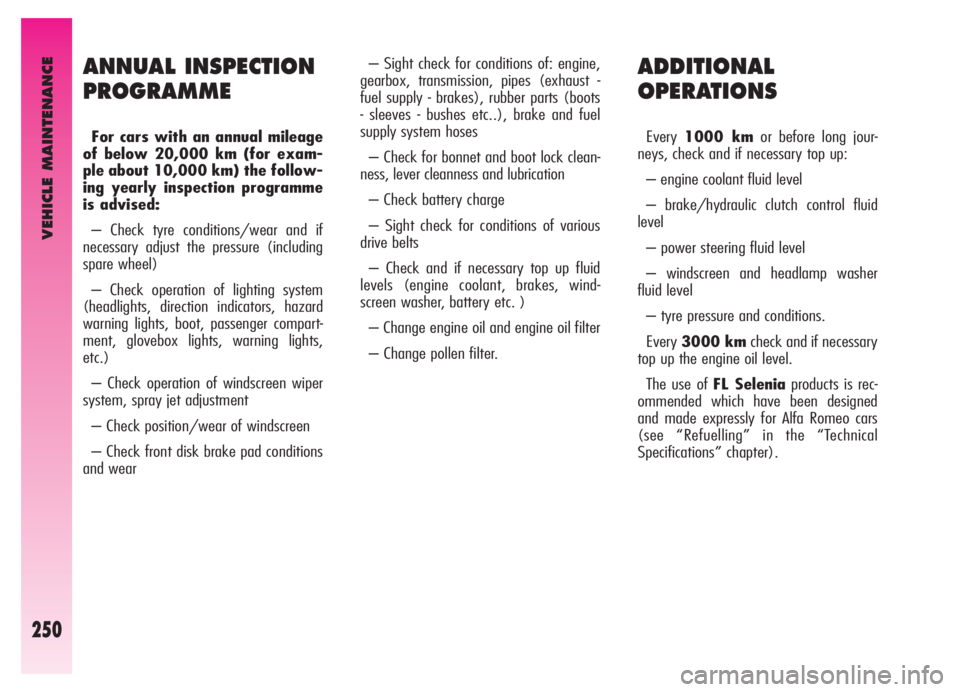
VEHICLE MAINTENANCE
250
ADDITIONAL
OPERATIONS
Every 1000 kmor before long jour-
neys, check and if necessary top up:
– engine coolant fluid level
– brake/hydraulic clutch control fluid
level
– power steering fluid level
– windscreen and headlamp washer
fluid level
– tyre pressure and conditions.
Every 3000 kmcheck and if necessary
top up the engine oil level.
The use of FL Seleniaproducts is rec-
ommended which have been designed
and made expressly for Alfa Romeo cars
(see “Refuelling” in the “Technical
Specifications” chapter).
ANNUAL INSPECTION
PROGRAMME
For cars with an annual mileage
of below 20,000 km (for exam-
ple about 10,000 km) the follow-
ing yearly inspection programme
is advised:
– Check tyre conditions/wear and if
necessary adjust the pressure (including
spare wheel)
– Check operation of lighting system
(headlights, direction indicators, hazard
warning lights, boot, passenger compart-
ment, glovebox lights, warning lights,
etc.)
– Check operation of windscreen wiper
system, spray jet adjustment
– Check position/wear of windscreen
– Check front disk brake pad conditions
and wear– Sight check for conditions of: engine,
gearbox, transmission, pipes (exhaust -
fuel supply - brakes), rubber parts (boots
- sleeves - bushes etc..), brake and fuel
supply system hoses
– Check for bonnet and boot lock clean-
ness, lever cleanness and lubrication
– Check battery charge
– Sight check for conditions of various
drive belts
– Check and if necessary top up fluid
levels (engine coolant, brakes, wind-
screen washer, battery etc. )
– Change engine oil and engine oil filter
– Change pollen filter.